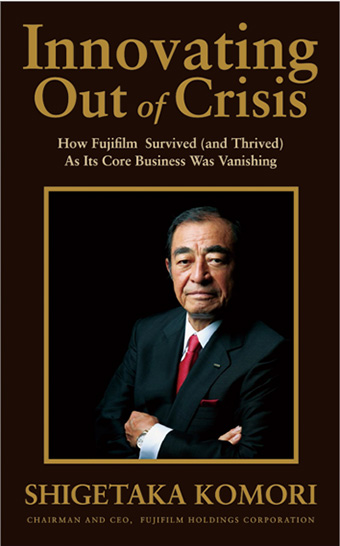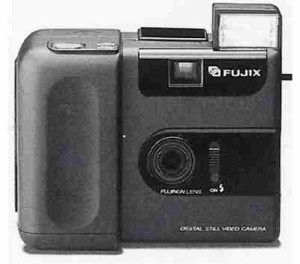Books: Innovating Out of Crisis
December 22, 2015 · 0 comments
By Jasper Sharp.
 Ask anyone what Japan’s greatest contribution to the world of film is, and few would offer “film itself” as an answer. Nevertheless, by the end of the twentieth century, one of the country’s best-known brands, Fujifilm, had successfully managed to corner the global market for raw print and negative stock with its domestically-developed Fujicolor process, beating out the industry giant Eastman Kodak after a struggle lasting almost 50 years.
Ask anyone what Japan’s greatest contribution to the world of film is, and few would offer “film itself” as an answer. Nevertheless, by the end of the twentieth century, one of the country’s best-known brands, Fujifilm, had successfully managed to corner the global market for raw print and negative stock with its domestically-developed Fujicolor process, beating out the industry giant Eastman Kodak after a struggle lasting almost 50 years.
The raw materials of the movie world have been but a small part of both enterprises’ wider activities in the field of image making. They receive only passing mention in Innovating Out of Crisis: How Fujifilm Survived (and Thrived) As Its Core Business Was Vanishing, Shigetaka Komori’s personal account of his role in steering the company through the noughties, when digital technologies emerged as a serious threat to the photographic industry’s core concerns. The resulting shake-up saw Eastman Kodak filing for bankruptcy protection in January 2012, highlighting the fact that the digitalisation of photography and cinema had passed the point of no return. In March 2013, Fujifilm itself ceased selling 35mm motion picture stock, yet at the same time the company was posting record profits. How was this so?
That the company managed to survive the coup-de-grace for analogue media is perhaps symptomatic of Japan’s post-war industrial rise through technical innovation, economic acumen and bloody-minded determination. Komori’s part in the David-and-Goliath battle against a larger and seemingly indomitable American rival makes for surprisingly compelling and insightful reading, and not just for business boffins.
When Fujifilm was founded in 1934, Kodak was already long-established, known worldwide for affordable stills cameras, film, chemicals and paper. Meanwhile, Fujifilm received its initial boost due to financial subsidy from the Japanese government during the war years, when Allied trade sanctions created a need to develop local photographic equipment and materials.
In the aftermath of the war, Fujifilm’s market remained domestic, bolstered by Japan’s world-famous love of photography. Even at this stage, the company’s main business went beyond basic film and paper for stills photography and motion picture stock, and included X-ray film, graphic arts materials, presensitised plates, and later magnetic tape for audio and video cassettes and computer storage (a simple innovation achieved by replacing the silver halide of photographic film with a magnetic powder).
In terms of its core business, Fujifilm overtook Kodak with the first high-speed colour negative film, F-11 400, in 1976. As Komori writes, “Fujifilm’s technology caught up with Kodak’s in the late 1970s, and by the 1980s we firmly believed we had technically surpassed Kodak in nearly all varieties of film.” By this stage, loosening trade barriers had already seen the American giant entering Japan’s previously closed market, but Fujifilm took a major international step in 1984 when it became official sponsor to the Los Angeles Olympic Games, held on “Kodak’s own U.S. backyard”. It built its first American factory in 1988.
Sales of the company’s primary product line peaked in 2000, the year of Komori’s appointment as Fujifilm president, and the company’s sales finally overtook that of Kodak in 2001 after four decades of competition. Nevertheless, the writing was on the wall. As affordable digital cameras became available, the migration away from colour photographic film was brutal – by 2010, worldwide demand had dropped below 10% of its 2000 peak.
Komori had anticipated these changes at the dawning of the digital age, and his observations as to where the future might lie provide some of the book’s most interesting revelations. The field of medical imaging is but one of the sidelines Fujifilm developed, pioneering diagnostic X-ray imaging technologies and bringing the Fuji Computed Radiography (FCR) product to the market in 1983 (it is still the world standard).
But perhaps the defining Eureka moment for Komori, prior to his promotion, was regarding the centrality of photographic film to the graphic arts. In the pre-digital age, newspapers, magazines and books had made extensive use of celluloid in their layout process: a full-colour magazine would be assembled by hand with separate layers of film for text, photos and illustrations overlaid to create a single plate for each page. The realisation that both the materials and the process would no longer be necessary with the advent of desktop publishing provided Komori with his first sign of things to come. Fujifilm’s decades of technological development and expertise in the photochemical domain would soon be redundant, and the “digital age would not be a battle between rival technologies, but an inescapable price war… and that price war would be intense, because technological barriers to entering the field of battle would have been lowered.”
Still, as he recalls, “I figured that when the digital age did come, it would arrive in stages… By my reckoning, it would take another thirty years for digital cameras to catch up to analog cameras in terms of resolution and sensitivity.” And so over the ensuing decades, Fujifilm began to position itself for the new era, significantly restructuring, acquiring a number of domestic and overseas operations in related areas, and investing heavily in research and development.
 In 1988, the company developed the world’s first full digital camera, the Fujifilm DS-1P, while in the new millennium, as the move towards full digitalisation looked like a done deal, Komori oversaw the creation of Frontier, Fujicolor’s digital minilab, which was installed into photo stores across the world to produce prints of far greater quality than users would have been able to produce at home, thereby extending the life of those high-street shops for whom printing and developing had been their business. Kodak had also explored this market, although unlike Fujifilm had relied on third-party manufacturers for the equipment and technology.
In 1988, the company developed the world’s first full digital camera, the Fujifilm DS-1P, while in the new millennium, as the move towards full digitalisation looked like a done deal, Komori oversaw the creation of Frontier, Fujicolor’s digital minilab, which was installed into photo stores across the world to produce prints of far greater quality than users would have been able to produce at home, thereby extending the life of those high-street shops for whom printing and developing had been their business. Kodak had also explored this market, although unlike Fujifilm had relied on third-party manufacturers for the equipment and technology.
Fujifilm’s expansion of its businesses interests also went in some unexpected directions, all related to its technological base in photochemicals and polarising protective films: pharmaceuticals, liquid crystal panels for TV, computer and cell-phone screens and even a cosmetics line, ASTRALIFE, launched in 2007 (apparently the gelatin used to create photographic film is derived from collagen, which makes up 70% of human skin).
Komori’s narrative of Fujifilm’s innovation and expansion, set against the slow decline of its more obdurate competitor, also takes into account other external factors influencing the company’s global positioning, such as the financial crisis brought on by the collapse of Lehman brothers in 2008, which saw the yen rise to an uncompetitive high, and the inevitable spectre of the Fukushima meltdown of 2011.
It’s all riveting stuff, although less engaging in the latter half, when Komori’s ongoing parallels between business and war, peppered with bullet-point like mantras from Sun Tzu, remind us that we are in the testosterone-charged milieu of the corporate samurai. “In business as in life,” he writes at the opening of a chapter entitled ‘A Battle that Cannot Be Lost’, “my mindset had always been one of refusing to give up. This same resolve is a cornerstone of the Japanese psyche… A fundamental principle of society is that everything in life is a struggle, a continuing battle.” In these sections, Komori’s first-person account of his part in the story falls just shy of occasionally coming across like a motivational speech by Gordon Gecko, delivered with a self-aggrandising tenor to rival even Tony Blair’s memoirs.
Books on Japanese moving image culture, be it anime, video games or cinema, have obstinately ignored the role played by the major companies that have created the tools of the trade, and yet one could reasonably argue that Fujifilm is central to much of this. In this respect, Innovating Out of Crisis goes into less detail than one might hope about the history of the company and the development and refinement of film industry-specific resources such as Fujicolor raw motion picture stock – a history that is glaringly absent from most published resources on Japanese cinema and even studies of colour moving image processes developed worldwide. Nevertheless, while such areas are not really the book’s raison d’etre, it is currently the best English-language source on this specific area.
For a general audience, there is plenty within Komori’s highly-readable explanation of his own management approach that can be applied to other fields. The book also serves as timely reminder of just how much a shock the digital revolution of the early 21st century was to all industries, shifting the business base of many from producing tangible physical goods into the more abstract realms of technologies and services.
Jasper Sharp is the author of The Historical Dictionary of Japanese Cinema. Innovating Out of a Crisis is available from Stone Bridge Press.
books, business books, cameras, film, Fujifilm, industry, Japan, Jasper Sharp, Kodak, Shigetaka Komori
Leave a Reply